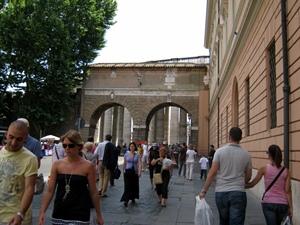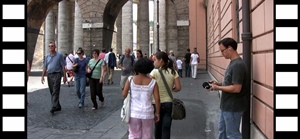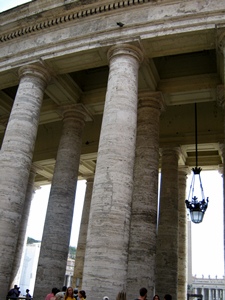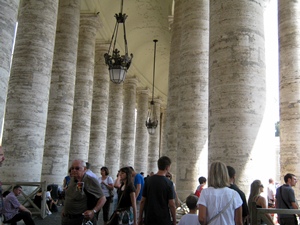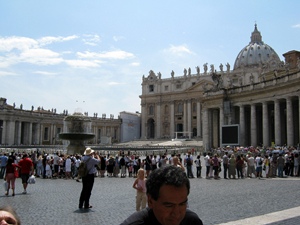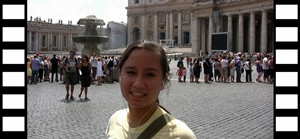Back to Sistine Chapel
Continue to St. Peter's Basilica
St.
Peter’s Square is the huge square in front of St. Peter’s Basilica. Despite its enormous size, it can’t be seen
when approaching from the Vatican Museums until you’re practically inside
it. This is because it’s bordered on
this side by a colonnade of four layers of columns which conspire to block any
view of the interior. This was probably
deliberate, as one of the principles of Baroque architecture or decoration was
to overwhelm the viewer (suddenly, if possible), and the Square’s designer,
Gian Lorenzo Bernini, was the king of Baroque.
And as we entered the Square, after working our way past the souvenir
vendors and the forest of columns, the design had the desired effect.
St.
Peter’s Square is surrounded to the north and south by two curving colonnades
that impart an elliptical shape to the Square.
The resulting ellipse has a major axis of 1115 feet and a minor axis of
787 feet. The colonnades consist of a
total of 284 columns, and atop the colonnades are 140 statues by the school of Bernini, all 10½ feet in height. At the center of the ellipse is an Egyptian
obelisk on top of a pedestal and surmounted by a cross, for a total height of
135 feet. At the “foci” of the ellipse
(not quite where the mathematical foci would be, but arranged symmetrically)
are two fountains.
When
Bernini began work on the Square in 1656, the building of St. Peter’s Basilica
had been completed for 30 years, and Bernini “inherited” the obelisk and one of
the fountains. The obelisk was
originally built in Egypt
during the Fifth Dynasty (around 2400 B.C.).
The Roman emperor Augustus had it moved from Heliopolis
to Alexandria,
where it stayed until 37 A.D. Then the
emperor Caligula had it brought to Rome and placed at the center of what came
to be known as the Circus of Nero (a huge arena for the entertainment of the
citizenry, featuring such events as chariot races and mass executions) on the
west bank of the Tiber. Over the
centuries, a great deal of Catholic construction (including the original St.
Peter’s Basilica and its successor) took place near the still-standing obelisk,
as this was the area where St. Peter was thought to have been crucified and
entombed. In 1586, Pope Sixtus V had the
obelisk moved to a prominent spot in front of the under-construction new
Basilica. Bernini used the obelisk and
the fountain (from 1613, by Carlo Maderno) in his new square, and had the
second fountain installed symmetrically across from Maderno’s fountain. To complete the square, a number of dwellings
(including a Palazzo designed by Raphael) had to be demolished.
The
result was a square where tens of thousands of visitors could see the Pope
delivering addresses or greetings from either a balcony above the entrances to
the Basilica, or from the windows of his residence in the Apostolic Palace,
visible above the colonnade to the northwest.
The square was still enclosed by houses and buildings to the east, but
Benito Mussolini had these demolished in 1936-37 to make way for the new Via
della Conciliazione, which reached all the way to the Tiber as a monumental
approach to the Vatican. This opened things up, but also eliminated
the Baroque “surprise” when approaching from this direction.
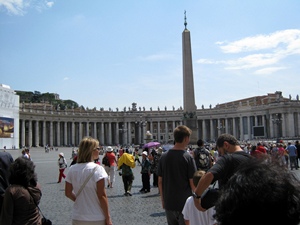
Entering the Square | 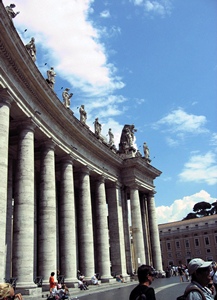
The Colonnade |
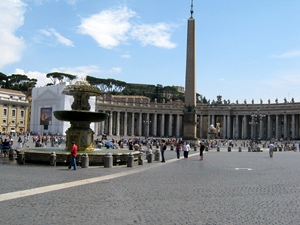
Fountain and Obelisk | 
Fountain |
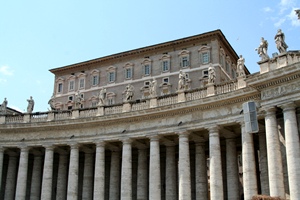
Pope's ResidenceOne
thing not provided by Bernini was shade for visitors forced to wait in a long
line on a hot late-June afternoon. This
was our predicament. The next thing we
wanted to see, understandably, was St. Peter’s Basilica. Admission was free, but to get in, one first
needed to go through a metal detector, of which there weren’t very many. So the line was long and slow and unshaded
and miserable.

Waiting in Line
SD Video (14.8 MB)
One would think that
people must be keeling over in July and August.
But we managed to stay upright and got through to a shady area after
passing through the detectors, and headed for the Basilica.
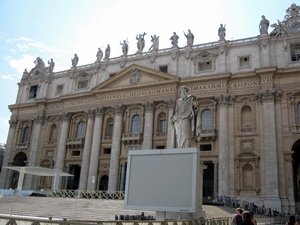
The Basilica | 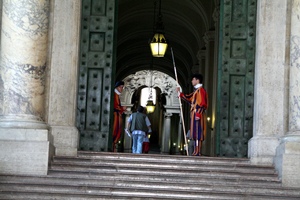
The Pope's Personal Security, The Swiss Guards |
Back to Sistine Chapel
Continue to St. Peter's Basilica
